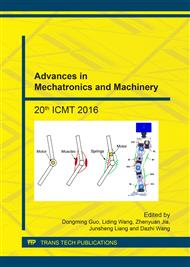p.218
p.224
p.230
p.236
p.242
p.248
p.254
p.260
p.265
Interactive Experience across Modern Age and Tradition: Application of Arduino in Shadow Play
Abstract:
Shadow play is a characteristic traditional art form throughout Eastern countries. However, it is currently in decline due to diverse reasons. This study explores a new form of Arduino based interactive experience between shadow play puppets and audience. Participants were able to manipulate the shadow play puppets via TouchOSC (Open Sound Control) on their mobile phones. The mobile phone controlled a Single-Chip Micro-computer (SCM) via WIFI, which in turn controlled steering engines connected to the shadow play puppets. The extent of action conformity between two players was evaluated via computer, and highlighted with a number of turn-on-lights. This system offers participants a way to experience the traditional shadow play art via modern communication tools, and introduce a novel interactive experience.
Info:
Periodical:
Pages:
242-247
Citation:
Online since:
July 2017
Authors:
Keywords:
Price:
Сopyright:
© 2017 Trans Tech Publications Ltd. All Rights Reserved
Share:
Citation:


